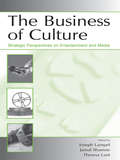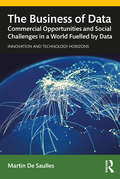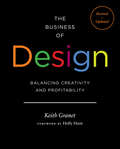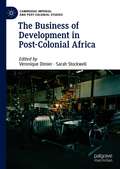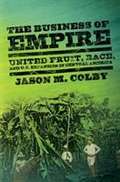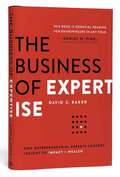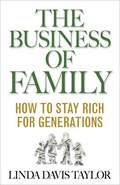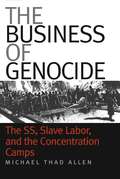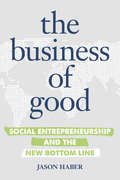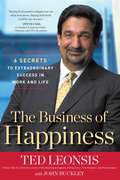- Table View
- List View
The Business of Creativity: How to Build the Right Team for Success
by Keith GranetLong known as the go-to management consultant of the design world, Keith Granet reveals more of his clear-eyed insights about running a creative business in this follow-up to his book The Business of Design. While aimed at creative enterprises, Granet's advice, quickly summarized as "know what you do best and focus on that," applies to any organization, small or large, commercial or nonprofit. He delves into the skill sets and people needed to grow a business, as well as the things you don't need (bad clients, bad employees, negative energy), in an engaging and easy-to-implement manner. His shrewd understanding, gleaned from decades of consulting for brands like Harrods, Pantone, John Varvatos, and Urban Archeology, makes this essential reading for anyone managing a business or thinking of starting one.
The Business of Criminal Justice: A Guide for Theory and Practice
by Daniel Adrian Doss Chengqi Guo Joo Young LeeThis book represents the manifestation of a new presentation of old perspectives within the discipline of criminal justice. It contains practical considerations of rendering such decisions, it is expected to be an appropriate reference among practitioner personnel.
The Business of Culture: Strategic Perspectives on Entertainment and Media (Organization and Management Series)
by Joseph Lampel Jamal Shamsie Theresa K. LantThe business of culture is the business of designing, producing, distributing, and marketing cultural products. Even though it gives employment to millions, and is the main business of many large and small organizations, it is an area that is rarely studied from a strategic management perspective. This book addresses this void by examining a wide range of cultural industries--motion pictures, television, music, radio, and videogames--from such a perspective. The articles included in this book will be helpful to individuals who seek a better understanding of organizations and strategies in the entertainment and media sector. But it should also provide valuable insights to managers and entrepreneurs who operate in environments that share the creative uncertainty and performance ambiguity that characterize most cultural industries.
The Business of Data: Commercial Opportunities and Social Challenges in a World Fuelled by Data (Innovation and Technology Horizons)
by Martin De SaullesThis book is about the rise of data as a driver of innovation and economic growth. It charts the evolution of business data as a valuable resource and explores some of the key business, economic and social issues surrounding the data-driven revolution we are currently going through. Readers will gain an understanding of the historical underpinnings of the data business and why the collection and use of data has been driven by commercial needs. Readers will also gain insights into the rise of the modern data-driven technology giants, their business models and the reasons for their success. Alongside this, some of the key social issues including privacy are considered and the challenges these pose to policymakers and regulators. Finally, the impact of pervasive computing and the Internet of Things (IoT) is explored in the context of the new sources of data that are being generated. This book is useful for students and practitioners wanting to better understand the origins and drivers of the current technological revolution and the key role that data plays in innovation and business success.
The Business of Design: Balancing Creativity and Profitability
by Keith GranetThe Business of Design debunks the myth that business sense and creative talent are mutually exclusive, showing design professionals that they can pursue their passion and turn a profit. For nearly thirty years, consultant Keith Granet has helped designers create successful businesses, from branding to billing and everything in between. Unlike other business books, The Business of Design is written and illustrated to speak to a visually thinking audience. The book covers all aspects of running a successful design business, including human resources, client management, product development, marketing, and licensing. This timely update on the tenth anniversary of the first edition includes new content on social media, working from home, and understanding and working with different generations, essential tools in today's ultracompetitive marketplace.
The Business of Development in Post-Colonial Africa (Cambridge Imperial and Post-Colonial Studies)
by Sarah Stockwell Véronique DimierThis collection brings together a range of case studies by both established and early career scholars to consider the nexus between business and development in post-colonial Africa. A number of contributors examine the involvement of European companies (most notably those of former colonial powers) in development in various African states at the end of empire and in the early post-colonial era. They explore how businesses were not just challenged by the new international landscape but benefited from the opportunities it offered, particularly those provided by development aid. Other contributors focus on the development agencies of the departing colonial powers to consider how far these served to promote the interests of European companies. Together these case studies constitute an important contribution to our understanding of both business and development in post-colonial Africa, redressing an imbalance in existing histories of both business and development which focus predominantly on the colonial period. This volume breaks new ground as one of the very first to bring the study of foreign companies and development aid into the same frame of analysis
The Business of Empire: United Fruit, Race, and U. S. Expansion in Central America
by Jason M. ColbyThe link between private corporations and U.S. world power has a much longer history than most people realize. Transnational firms such as the United Fruit Company represent an earlier stage of the economic and cultural globalization now taking place throughout the world. Drawing on a wide range of archival sources in the United States, Great Britain, Costa Rica, and Guatemala, Colby combines "top-down" and "bottom-up" approaches to provide new insight into the role of transnational capital, labor migration, and racial nationalism in shaping U.S. expansion into Central America and the greater Caribbean. The Business of Empire places corporate power and local context at the heart of U.S. imperial history. In the early twentieth century, U.S. influence in Central America came primarily in the form of private enterprise, above all United Fruit. Founded amid the U.S. leap into overseas empire, the company initially depended upon British West Indian laborers. When its black workforce resisted white American authority, the firm adopted a strategy of labor division by recruiting Hispanic migrants. This labor system drew the company into increased conflict with its host nations, as Central American nationalists denounced not only U.S. military interventions in the region but also American employment of black immigrants. By the 1930s, just as Washington renounced military intervention in Latin America, United Fruit pursued its own Good Neighbor Policy, which brought a reduction in its corporate colonial power and a ban on the hiring of black immigrants. The end of the company's system of labor division in turn pointed the way to the transformation of United Fruit as well as the broader U.S. empire.
The Business of Europe is Politics: Business Opportunity, Economic Nationalism and the Decaying Atlantic Alliance
by Dimitris N. ChorafasIt is no secret that Europe is currently undergoing a major economic and social crisis, so it is essential says Dimitris Chorafas that leaders of industry and finance within the EU, or doing business with the EU, know what is going on. What is it that threatens competitiveness and produces obstacles to providing a vibrant business landscape in the European Union? This book offers insight into the particular nature of the European cocktail of business and politics, explaining how that bears on trade and relations between, for example, continental Europe and the UK, across the Atlantic with the US, with Russia and with Asia. Dr Chorafas explains and critiques Europe's conflicting aims and what he describes as its wanting business plan. Case studies to illustrate the consequences for business of the deficiencies identified are included. With its mix of rigorously researched background and forthright argument, this timely book will satisfy those academics with an interest in the issues addressed and will also serve as a planning tool for business leaders and government executives trying to determine what they can do at enterprise level. The challenge is to survive and prosper in an environment where 'business is politics'.
The Business of Event Planning: Behind-the-Scenes Secrets of Successful Special Events
by Judy AllenPractical tools and expert advice for professional event planners Before planning an event, there is much that must be done behind the scenes to make the event successful. Before any thought is even given to timing or location of the event, before the menus are selected and the decor designed, there are proposals to be written, fees and contracts to be negotiated, and safety issues to be considered. This book takes you behind the scenes of event planning and explains every aspect of organizing and strategic planning. This book will be of value to both the professional event planner and to clients who are dealing with planners. Its comprehensive coverage includes: how to prepare winning proposals, and how to understand them if you are the client; how to determine management fees; negotiating contracts; safety issues; designing events in multicultural settings; and new technology that makes operations more efficient (such as online registration and response management, database project management tools). The book also includes practical tools such as sample letters of agreement, sample layouts for client proposals, forms, and checklists. Professional event planner Judy Allen offers first-time or professional event planners all the top-class advice they need to make their special events come off without a hitch.
The Business of Expertise: How Entrepreneurial Experts Convert Insight to Impact + Wealth
by David C. BakerThis passionate expertise manifesto is intended to elevate the impact of advisors who sell insight as entrepreneurs. Three foundational chapters form the basis of the entire book: experts develop insight by isolating patterns in data; they convert those insights to wealth by crafting a unique positioning for which few available substitutes exist; and their confidence grows as the marketplace embraces their application of expertise. <p><p>The next fifteen chapters--building on that foundation--each answer a single question, starting with the role of expertise in a developed society, how important it is for experts to love the hard work required to hone their expertise, and how to see all that in the context of their own purpose in the world. We pause to dig deeper by examining the very narrow overlap between expertise and entrepreneurship: the narrow slice of humanity for which this book was written, with a nod to how easy it is for those entrepreneurial experts to be pulled off mission to explore new things.
The Business of Family
by Linda Davis TaylorThe Business of Family teaches readers how to write their own family business plan using time-tested strategies from the corporate world to provide a practical, user-friendly method that ensures their family knows where it's been, where it's headed, and how it's going to get there.
The Business of Farm Animal Welfare (The Responsible Investment Series)
by Nicky Amos Rory SullivanGlobally, nearly 70 billion animals are farmed annually for meat, milk and eggs. Two-thirds of these are farmed intensively. The views held by food companies on animal stewardship, and the management practices and processes that they adopt are, therefore, of critical importance in determining the welfare of these animals. Yet, despite the scale of the food industry’s impact, farm animal welfare remains a relatively immature management issue. There is a lack of consensus around the specific responsibilities companies have for farm animal welfare, and around how companies should treat the animals in their or in their suppliers’ care. This book, The Business of Farm Animal Welfare, provides an extensive, authoritative analysis of current corporate practice on farm animal welfare. It critically reviews and assesses the ethical and business case for action. Through a series of practitioner case-studies, it describes how companies have addressed farm animal welfare in their operations and supply chains. It analyses the key barriers to companies adopting higher standards of farm animal welfare, and offers a series of practical recommendations to companies, consumers and policy makers on the role that they might play in raising farm animal welfare standards across the food industry. As the first comprehensive account of business and farm animal welfare, this book is an essential resource for researchers, practitioners and general readers looking to understand and influence corporate practice on farm animal welfare.
The Business of Fashion: Designing, Manufacturing, And Marketing
by Leslie Davis Burns Kathy K. Mullet Nancy O. BryantLearn how fashions lines are designed, manufactured, marketed, and distributed. The book covers the full supply chain - from textiles to fashion brand production to retailing - as well as supply chain management, and competitive strategies, so that you can be successful in your future career. Topics covered include sustainable design for a circular economy, 3-D printing, fashion entrepreneurship, disruptions in fashion calendars, supply chain transparency, impact of social media, growth and evolution of online retailing, expanded omnichannel strategies, and changes in international trade, among others. Case studies, a Career Glossary, and key terms help you connect concepts to practice.
The Business of Fine Art Photography: Art Markets, Galleries, Museums, Grant Writing, Conceiving and Marketing Your Work Globally
by Thomas WernerThis guide for aspiring and exhibiting photographers alike combines practice and concept to provide a roadmap to navigating, and succeeding in, the fine art photography marketplace locally, domestically, and internationally. Join former New York gallery owner, international curator, and fine art photographer Thomas Werner as he shares his experiences and insights from leading curators, gallerists, collectors, auctioneers, exhibiting photographic artists, and more. Learn how to identify realistic goals, maximize results, work with galleries and museums, write grants, develop strong nuanced imagery, and build a professional practice in a continually evolving field. Featuring dozens of photographs from international practitioners, and a robust set of resources, this book will ensure you have the tools to give you the opportunity for success in any marketplace. Whether you are a student, aspiring photographic or video artist, or a photographer changing careers, The Business of Fine Art Photography is your guide to starting and growing your own practice.
The Business of Flipping Homes: Short-Term Real Estate Investing for Long-Term Wealth
by William Bronchick Robert DahlstromWhether you're looking to make a career out of flipping homes or see it as a part-time venture, you can make fast money legitimately. Before you get started, you need to know the right way to flip, regardless of local market conditions and current economic trends. There's more to flipping than redoing a kitchen or staging a property. Every deal is different, and each investor must have a clear business strategy. Expert investors William Bronchick and Robert Dahlstrom have learned how to be successful in all types of markets—and now they share their secrets with you. From the bestselling authors of Flipping Properties, which brought the term "flipping" to American households, The Business of Flipping Homes is an A-to-Z guide for both new and seasoned investors. The book explains what flipping is and isn't, goes beyond the investment of a basic single-family home, and demonstrates how to find, renovate, and sell properties using proven methods. With more than 40 years combined experience in buying and selling investment properties, Bronchick and Dahlstrom explain how to avoid many of the pitfalls and issues that could drain your funds and come back to haunt you. They give systematic approaches on long-term planning, including how to find and work with partners, structure a business, and utilize your specific talents, resources, and aspirations in realistic ways. You'll learn how to figure out timelines, work with real-estate agents, understand the paperwork, analyze the numbers, utilize technology, and, most important, find the money.
The Business of Friendship: Making the Most of Our Relationships Where We Spend Most of Our Time
by Shasta NelsonWant to be happier, healthier, and enjoy your job more?Make better friends at work.The data is in. It is virtually impossible to feel connected and supported in life when we don&’t feel that way where we spend most of our time—at work. Whether we work remotely or in an office, who we interact with consistently impacts everything from our longevity and mental health to our career success and job satisfaction.Unfortunately, too many of us don&’t feel like we belong at work in the ways we need. In addition to the 20% of us who report feeling lonely at work almost all the time, 60% of us report feeling it at least half the time., and that disconnection is taking a toll: more stress and burnout, less energy, decreased loyalty to our company, and increased dread for &“Monday morning.&”In The Business of Friendship, Shasta Nelson, a friendship expert, unpacks the distinct ways we can make work relationships the healthiest they can be, both for the sake of the employee and the mission of the company. She inspires readers to see why friendship is crucial to our health and our careers and teaches us exactly how to develop the supportive and meaningful connections we need.Our organizations benefit as well when our leaders encourage friendships at work. The outcome is higher levels of workplace productivity, employee retention, safety, innovation, collaboration, and profitability. In fact, having a best friend at work we are seven times more engaged in our job, which translates to better customer service, less absenteeism, fewer workplace accidents, and more loyalty to our organizations. The best employees are the ones who feel connected.Work is to adults as school is to kids—a consistent place with familiar people. But too few of us are taking advantage of this environment. This leaves us no other choice but to try to get all our relational needs met in our off-work hours, where most of us already report feeling &“too busy.&” The result? We stay lonely, wishing for more meaningful connections.Through Shasta&’s stories, research, and practical guidance, sheBreaks down what creates healthy bonds and reveals the 3 requirements necessary in all healthy relationships and teamsHelps managers and employees assess the health of their relationships and learn ways to repair and improve themProvides advice for addressing some of the biggest fears around workplace friendships, such as increased drama, favoritism, confidentiality, gossip, toxic coworkers, relationship with bosses, and potential romantic attractionsThe Business of Friendship is for those who are ready to maximize the two most significant factors of our wellbeing—career and relationships. Whether you are a leader or an employee, when you feel more connected and supported at work, everyone wins.
The Business of Gamification: A Critical Analysis (Routledge Advances in Management and Business Studies)
by Peter Zackariasson Mikolaj DymekAt the turn of the century the term "gamification" was introduced as a concept to understand the process of using game mechanics in "non-game" contexts. The impact of gamification was soon evident to business practices where it had impact both on marketing and, more broadly, on the organizations themselves. As the number of individuals playing video games grows, there seem to be an acceptance of game mechanics elsewhere. Its effectiveness is highly dependent on both technical possibilities and cultural acceptance, two factors present today. The aim of The Business of Gamification is to critically analyze the practical and theoretical consequences of gamification. Practically, how has gamification been applied in businesses to this point, and what are the future scenarios? Theoretically, what are the contributions of gamification to existing academic knowledge? How does this change our understanding of how business are performing and its consequences, for organizations, consumers, and society in general? This edited volume contains new, and stringent, perspectives on how gamification is contextualized in business settings, both in theory as well as in practice. This book will provide a wealth of research for individuals seriously interested in the industry at the academic level. As a result, this book will serve as a reference in curricula associated with video game development for years to come.
The Business of Genocide
by Michael Thad AllenDuring World War II, hundreds of thousands of prisoners were worked to death by the Nazis under a brutal system of slave labor in the concentration camps. By 1942, this vast network of slavery extended across all of German-occupied Europe, but the whole operation was run by a surprisingly small staff of bureaucrats--no more than 200 engineers and managers who worked in the Business Administration Main Office of the SS. Their projects included designing and constructing the concentration camps and gas chambers, building secret underground weapons factories, and brokering slave laborers to private companies such as Volkswagen and IG Farben. The Business of Genocide powerfully contradicts the assumption that the SS forced slavery upon the German economy, demonstrating that instead industrialists actively sought out the Business Administration Main Office as a valued partner in the war economy. Moreover, while the bureaucrats who oversaw Holocaust operations have often been seen as technocrats or simple "cogs in the machinery," the book reveals their ideological dedication, even fanatical devotion, to slavery and genocide in the name of National Socialism.During World War II, hundreds of thousands of prisoners were worked to death by the Nazis under a brutal system of slave labor in the concentration camps across all of German-occupied Europe. The whole operation was run by a surprisingly small staff of bureaucrats--no more than 200 engineers and managers who worked in the Business Administration Main Office of the SS. Michael Thad Allen powerfully contradicts the assumption that the SS forced slavery upon the German economy, demonstrating that instead industrialists actively sought out the Business Administration Main Office as a valued partner in the war economy. Moreover, while the bureaucrats who oversaw Holocaust operations have often been seen as technocrats or simple "cogs in the machinery," this book reveals their ideological dedication, even fanatical devotion, to slavery and genocide in the name of National Socialism.-->
The Business of Giving
by Peter GrantThe Business of Giving reviews current thinking and surveys the key techniques any philanthropist or grantmaker should adopt. It also outlines a generic social investment process that can be utilized for all philanthropic or grantmaking programmes. Essential reading for all engaged in or with an interest in philanthropy or civil society in general.
The Business of Good: Social Entrepreneurship and the New Bottom Line
by Jason HaberThe Business of Good narrates the story behind social entrepreneurship as told by the individuals compelled to create a change in the world--not just another business. Serial and social entrepreneur Jason Haber intertwines case studies, anecdotes, and initiatives that have become part of the larger narrative of entrepreneurship.From Main Street to Wall Street, today's social entrepreneurs are rebooting capitalism, challenging the charitable industrial complex, and are disrupting the way companies do business with exciting innovations designed to solve society's most vexing problems. In this book, Haber examines Capitalism 2.0, philanthropy, and the role and power of media alongside the world's response as social entrepreneurship changes how we give, how we invest, and who we are.
The Business of Greening (Routledge Library Editions: Environmental and Natural Resource Economics)
by Stephen FinemanThe Business of Greening, first published in 2000, debates the relationship between business and greening, and the future form this relationship could take. The book gives voice to industrial actors - employees, employers, managers, technical specialists, regulators - in the context of their organizations, within industrial sectors or as part of wider institution regimes. The business of greening is taken as socially constructed, shaped through tensions and competing interests. It produces outcomes that are sometimes unexpected, sometimes hopeful. These outcomes are explored by examining a range of workers, including estate agents, bankers, bakers, printers, regulators, in small and large corporations. Contributors write from a wide range of different social sciences including sociology, geography, organizational science and psychology. This title will be of particular interest to students and researchers of environmental and business studies, and to those who shape environmental policy in government and industry.
The Business of Happiness: 6 Secrets to Extraordinary Success in Life and Work
by Ted Leonsis John BuckleyWhat's Your Plan For Happiness?When the plane he was on prepared for a crash landing, Ted Leonsis asked himself the crucial question, If today is my last day on earth-will I die happy?. . . and realized the answer was no. Despite having achieved massive business success-he was a self-made multi-millionaire at the age of twenty-seven-he realized he would die unfulfilled. He told God that if he survived, he would turn his life around, give back more than he took, and pursue happiness. After walking off that plane, he got to work.In The Business of Happiness, Ted Leonsis, owner of the Washington Capitals and former group president and vice chairman of AOL, shares the six secrets of happiness he discovered since that fateful plane ride. Treating happiness as a goal like any other, he made a list of what he thought would make him happy, and made a plan to achieve his goals. Along the way he discovered an incredible truth-business or financial success doesn't bring happiness, but happiness can bring you business and financial success.Inside The Business of Happiness, you'll learn, as Ted did:* How success follows happiness (not the other way around)* The importance of having a "double bottom line"-and how you really can do well by doing good* The key to finding your own higher calling* Why you should have a life plan for happiness, just as an entrepreneur has a business plan to launch and sustain a business* The six essential secrets that lead to happiness and success* How Ted lived his journey from a Brooklyn kid to sports team franchise owner-and the lessons learned along* What was on Ted's list-and what should be on yoursNothing is more universal than the desire to be happy. Ted Leonsis has made a lifetime's study of that desire and how to achieve it-and now he wants to share what he's learned with you. The Business of Happiness will show you how to become the happy, successful, and generous person you've always wanted to be.
The Business of Happiness: 6 Secrets to Extraordinary Success in Work and Life
by Ted Leonsis John BuckleyLeonsis, a business, sports, and media mogul, proves and explains that success may or may not make one happy, but happiness will almost always make one more successful.
The Business of Healthcare Innovation
by Lawton Robert BurnsThe Business of Healthcare Innovation is a wide-ranging analysis of business trends in the manufacturing segment of the healthcare industry. It provides a thorough overview and introduction to the innovative sectors fueling improvements in healthcare: pharmaceuticals, biotechnology, platform technology, medical devices and information technology. For each sector, the book examines the basis and trends in scientific innovation, the business and revenue models pursued to commercialize that innovation, the regulatory constraints within which each sector must operate and the growing issues posed by more activist payers and consumers. Specific topics include market structure and competition, the economics and rationale of product development, pricing, sales and marketing, contract negotiations with buyers, alliances versus mergers, business strategies and prospects for growth. Written by professors of the Wharton School and industry executives, the book shows why healthcare sectors are such an important source of growth in any nation's economy.
The Business of Healthcare Innovation
by Lawton Robert BurnsThe tech sectors are the least understood portion of the healthcare system, but the ones that supply most of the innovation in healthcare services and generate most revenue. Fully updated for this third edition, The Business of Healthcare Innovation is a wide-ranging analysis of business models and trends in the tech sectors of the healthcare industry. It provides a thorough overview of and introduction to the innovative sectors that fuel improvements in healthcare: pharmaceuticals, biotechnology, life science startups, medical devices and information technology. For each sector, the book examines the trends in scientific innovation, the science behind that innovation, the business and revenue models pursued to commercialize that innovation, the regulatory constraints within which each sector must operate and the growing issues posed by activist payers and consumers. From a combination of academic and industry perspectives, the authors show why healthcare sectors are such an important source of growth in any nation's economy.


